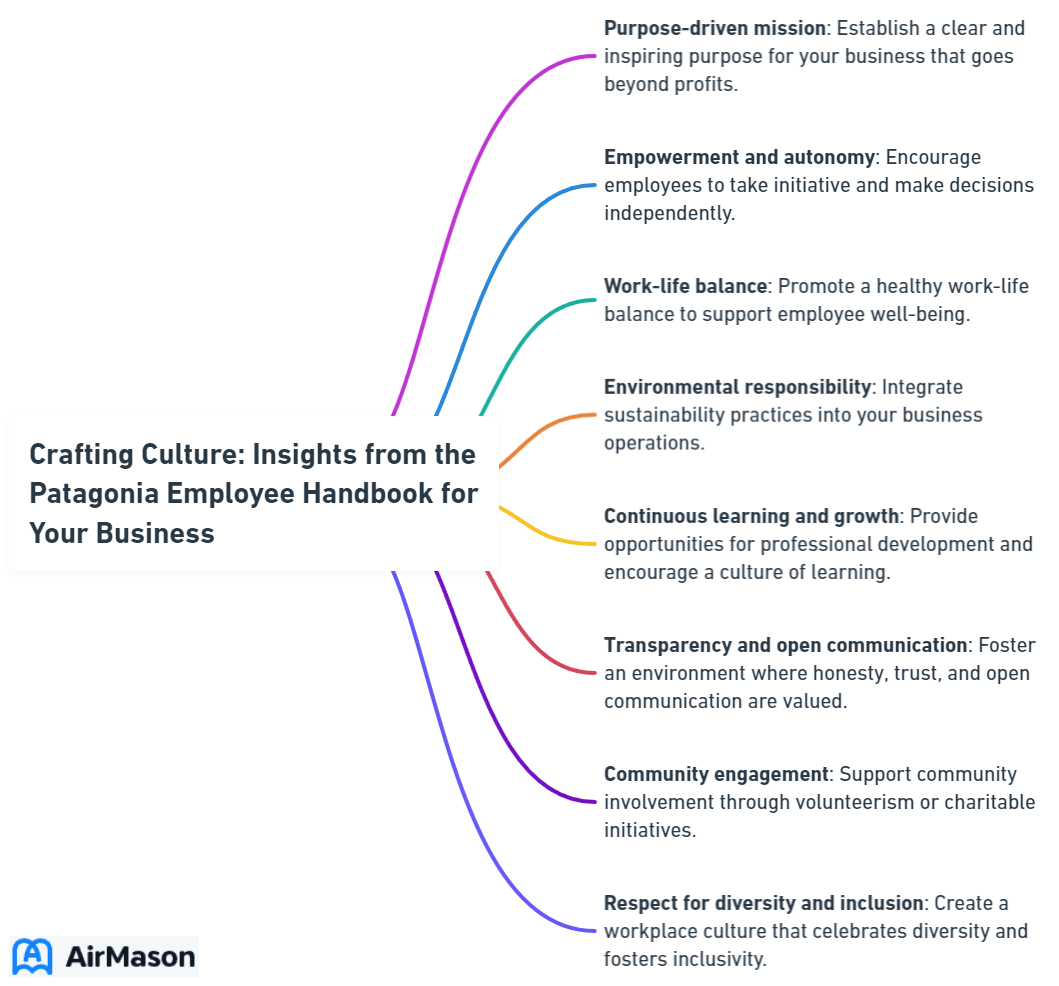
Looking to understand the Patagonia employee handbook? This guide cuts through the noise and zeroes in on the cultural pillars—environmental commitment, fairness, and work-life balance—that inform Patagonia’s employee experience. By outlining core principles and providing a lens on applying these in different organizational settings, you’ll gain insight into what drives Patagonia’s renowned workplace environment without diluting the details awaiting in the rest of our exploration.
Key Takeaways
- Patagonia’s culture embodies quality, integrity, environmentalism, and justice, with major emphasis on sustainability practices including self-imposed tax and efforts to remove virgin petroleum materials from products by 2025.
- Patagonia champions employee empowerment and work-life balance through policies like flexible work schedules, comprehensive health insurance, and strong parental support, including onsite childcare and special benefits for breastfeeding mothers.
- By embracing corporate activism and robust social responsibility, Patagonia maintains an attractive work culture with low turnover, which can serve as a model for integrating similar practices into other organizations for positive impact and community-building.
Employee Handbook Safety
Employee Handbook Safety is an essential component of any workplace, ensuring that all employees understand and adhere to safety protocols and procedures. Within the Employee Handbook Safety section, employees will find detailed information regarding emergency procedures, proper equipment usage, and hazard reporting protocols. It outlines the company’s commitment to creating a safe work environment for all employees and visitors. By familiarizing themselves with the guidelines outlined in the Employee Handbook Safety section, employees can contribute to maintaining a secure workplace for themselves and their colleagues. Regular reviews and updates to this section are crucial to ensuring that it remains relevant and effective in promoting a culture of safety within the organization.
Unveiling the Essence of Patagonia’s Culture through Its Handbook

Patagonia’s unique culture, often referred to as Patagonia culture, is rooted in a set of inspiring principles that constitute the company’s ethos. The cornerstones of their unique culture are:
- Quality
- Integrity
- Environmentalism
- Justice
- A commitment to doing things their own way
This ethos is clearly reflected in their employee handbook, emphasizing the importance of crafting the best outdoor clothing while recognizing the threat of extinction to all life on earth.
The Backbone of Patagonia’s Ethos
Patagonia’s culture centers around its dedication to environmental sustainability. The company’s handbook, titled “Crafting Culture: Insights from the Patagonia Employee Handbook for Your Business,” highlights key initiatives like its self-imposed Earth tax, 1% for the Planet, which supports environmental nonprofits. Moreover, Patagonia’s goal to eliminate virgin petroleum material from their products by 2025 reflects their commitment to sustainability, and they maintain strong environmental responsibility and animal welfare programs.
The company’s ethos is deeply embedded in its corporate practices, prioritizing the creation of top-quality products that embody principles of function, repairability, and durability.

Employee Engagement and Empowerment
Patagonia’s employee handbook, ‘Let My People Go Surfing’, promotes trust, autonomy and a sense of purpose, thereby empowering employees with flexibility. With clear core values guiding each decision, employees are encouraged to contribute to the company’s direction and success, fostering a sense of belonging and self-esteem.
This approach supports the world’s transition to a more sustainable future and sustainable energy, avoiding unnecessary harm to the environment and addressing the environmental crisis.
Best Buy Employee Policy
The Best Buy employee policy outlines the guidelines and expectations for all employees within the company. It encompasses various aspects such as code of conduct, employee benefits, and procedures for handling different situations. Understanding and adhering to the Best Buy employee policy is crucial for maintaining a positive work environment and ensuring smooth operations. Employees are encouraged to familiarize themselves with the policy to uphold the values and standards of the company. Additionally, the policy serves as a reference point for addressing any concerns or issues that may arise during employment.
Sustaining a Legacy of Responsibility
An unwavering commitment to responsibility forms the foundation of Patagonia’s legacy. This is evident in their dedication to:
- Corporate and social/environmental responsibility
- Long-term thinking
- Integrity
- Making responsible choices
These are all fundamental aspects of their business operations and decisions.
Implementing policies like:
- using preferred materials
- eliminating virgin petroleum materials in their products
- providing financial support to environmental nonprofits through their 1% for the Planet program
- focusing on hiring individuals who share these values
reflect Patagonia’s dedication to environmental and social responsibilities.
Their employees are also motivated to actively engage in environmental sustainability through the Environmental Internship Program.
A Deep Dive into Patagonia’s Employee Policies

The exceptional employee benefits and work-life balance policies demonstrate Patagonia’s commitment to its employees. The company provides comprehensive health insurance for both full-time and part-time employees and covers abortion care, reflecting their dedicated support for their employees’ well-being.
They also motivate and empower employees to take on environmental responsibility at work through their self-imposed Earth tax, 1% for the Planet, and robust environmental and social responsibility initiatives, showing their unwavering dedication to sustainability.
Flexibility for a Balanced Life
Patagonia’s dedication to work-life balance is showcased through its flexible work schedules, which include:
- A 9/80 work schedule for a three-day weekend every other week
- ‘Let my People go Surfing Flex-time Policy’
- Remote work options within Europe for up to 12 weeks per year
- Varied schedules for different roles.
These initiatives allow employees to strike a harmonious balance between work commitments and personal interests like surfing or skiing.
Onsite Childcare and Family Support
Going above and beyond, Patagonia provides access to an onsite childcare center, demonstrating their commitment to family-friendly benefits. The company’s trained teachers and focus on outdoor activities align with the company’s values, creating a nurturing environment for the children. It’s seamlessly integrated with the company-paid health care, ensuring comprehensive support for employees and their families.
Their commitment to supporting breastfeeding mothers even extends to covering expenses for the mother, baby, and a nanny during business trips.
Embracing Environmental Initiatives at Work
The commitment of Patagonia to sustainability is reflected in its workplace practices and policies. Their goals are ambitious, including eliminating virgin petroleum material in their products by 2025, prioritizing environmentally friendly materials, and reducing reliance on fossil fuels by transitioning to recycled polyester. They also demonstrate their commitment through the self-imposed Earth tax, 1% for the Planet, to support environmental nonprofits, and ensure fair labor practices and safe working conditions through diligent activities.
Patagonia also motivates its employees to actively engage in environmental sustainability, fostering a culture of hands-on engagement in environmental efforts.
Crafting Your Own Culture-Driven Handbook

A culture-driven handbook, tailored to your company, can powerfully shape your unique culture and values. By identifying the most vital values, aligning these with the organization’s mission and vision, and infusing these core values into the handbook, you can energize and solidify the core values of your company.
Incorporating sustainability into the handbook can promote a culture of environmental responsibility. This can be done by:
- Outlining the significance of sustainability
- Explaining the role of employees in achieving sustainable goals
- Embedding sustainability in the learning and development stages of the employee experience
Defining Your Company’s Core Values
For any company, it’s vital to establish clear core values. Core values like:
- Craftsmanship
- Curiosity
- Customer Obsession
- Integrity
Values have fueled the success of their respective companies. These values are the driving force behind a company’s actions, behavior, and overall company’s culture, playing a crucial role in shaping marketing strategies, human resources practices, and product development.
Integrating Sustainability into Company Policies
The inclusion of sustainable practices in your company policies can foster a culture of environmental responsibility. Some inspiring examples of sustainable practices that companies can incorporate into their policies include:
- Switching to renewable energy
- Minimizing waste and emissions
- Partnering with nonprofit organizations
- Developing sustainable products and services
Patagonia has set the bar high by:
- Moving toward 100% renewable and recycled materials
- Implementing social responsibility programs
- Supporting environmental nonprofits through their self-imposed Earth tax
- Promoting the use of used and refurbished apparel
Encouraging Employee Participation and Feedback
Encouraging employees to participate in the development of your handbook can instill a sense of ownership and engagement. Here are some strategies to motivate employees to actively participate in the handbook’s creation:
- Make the handbook easily accessible to all employees.
- Schedule one-on-one sessions to align personal aspirations with company objectives.
- Share the compelling narrative of the company culture.
By implementing these strategies, you can foster employee engagement and implement solutions that create a handbook truly reflecting the values and goals of your organization.
Moreover, continuous feedback promotes open communication, skill development, and team empowerment.
Patagonia’s Influence on Talent Acquisition and Retention

The significant success of Patagonia is largely attributed to its culture-driven approach to hiring and employee retention. The company prioritizes not only professional skills but also the match between candidates and the company’s mission and values. They steer clear of typical hiring methods, opting to tap into their own networks to seek out individuals who share their passion for environmental and social sustainability.
The strength of their employee retention strategies and the attractiveness of their company culture are evident in their turnover rate of only 4%, significantly lower than the national average turnover rate of 57%.
Hiring for Cultural Contribution
Through multiple rounds of tailored interviews with their talent acquisition team members, Patagonia’s hiring process enables candidates to showcase their skills and demonstrate their fit within the company culture. The company values candidates who are genuinely interested in helping others and embody core values of quality, integrity, environmentalism, justice, and a willingness to challenge conventions.
The Impact of Culture on Employee Turnover
Patagonia’s strong company culture has led to low employee turnover and a competitive job market. The key factors that make Patagonia’s company culture effective in reducing employee turnover are:
- Flexibility
- Integrity
- Hiring activist employees
- Encouraging employee activism
Zappos Employee Handbook PDF
The Zappos employee handbook PDF serves as a comprehensive guide for all employees, outlining the company’s policies, procedures, and expectations. It covers a wide range of topics, including workplace conduct, benefits, and career development opportunities. Accessible in digital format, the Zappos employee handbook PDF ensures that every team member has easy access to vital information. This document is regularly updated to reflect changes in company policies and industry standards, ensuring that employees are always informed and aligned with the organization’s values and goals. Zappos prioritizes transparency and clarity, making the employee handbook PDF an essential resource for both new hires and seasoned professionals alike.
Implementing Patagonia-Inspired Practices in Your Organization

Integrating elements of Patagonia’s culture and practices into your workplace can yield rewards. Here are some ways to do it:
- Embrace work flexibility
- Promote a healthy work-life balance
- Encourage authenticity
- Foster innovation
By implementing these practices, organizations can elevate their own work environment.
Building connections through environmental involvement, supporting nonprofits, and managing the impacts of your business with a robust social-responsibility program can cultivate a sense of community within your organization like Patagonia.
From Policy to Practice: Making Sustainability Actionable
It’s imperative to foster a culture of environmental responsibility in your workplace by implementing sustainable practices. By embracing sustainable practices like:
- reducing carbon footprint
- using renewable energy
- implementing recycling programs
- promoting green commuting
- adopting sustainable procurement practices
Workplaces can make a significant impact.
Patagonia’s active work in reducing carbon emissions and transforming their product manufacturing processes is a testament to their commitment to sustainability.
Building a Community within the Workplace
Fostering a sense of community and belonging among employees can contribute to a positive work environment. Here are some ways to build connections and cultivate a sense of community within your organization, like Patagonia:
- Get involved in environmental initiatives
- Support nonprofits and charitable organizations
- Implement a robust social-responsibility program to manage the impacts of your business
By following these strategies, you can create a strong sense of community and belonging among your employees.
Leading by Example: Corporate Activism and Social Responsibility
Embracing corporate activism and social responsibility can help your organization make a positive impact on the world. Patagonia’s robust social-responsibility program, firmly standing up for environmental and social issues such as climate change, voting rights, and the defense of public lands through various impactful activism projects, is an inspiring example of corporate activism and social responsibility.
Maximizing the Potential of Your Employee Handbook
An effective and inspiring employee handbook titled “Company Culture and Policies” can serve as a powerful tool in shaping your company’s culture. Some crucial inclusions for a comprehensive handbook are:
- Organizational information
- Compensation and benefits
- Code of conduct
- Leave of absence policies
- Equal employment and non-discrimination policies
- Notice and disclaimer/acknowledgement of receipt
- Employment at-will policy
- Company policies
- Legal requirements
- State and federal regulations
- Expectations
- Standards of conduct
- Computers and social media policies
- Non-discrimination policy
In addition to these, employee handbooks should be regularly updated to ensure compliance with changing laws and regulations.
Outlining Clear Expectations and Guidelines
It’s of utmost importance to provide clear expectations and guidelines for employees in the handbook. Here are some key points to include:
- Job roles and responsibilities should be clearly articulated
- Performance expectations should be clearly defined
- Success metrics and key performance indicators should be outlined
- Address any questions employees have about your expectations and ensure they understand what your expectations are.
The handbook reflects the company’s expectations, rules, and policies, and should also outline them. Additionally, it is important to establish boundaries and communicate expected behavior, performance standards, and responsibilities for employees.
Using the Handbook as a Tool for Inspiration and Growth
A culture-driven and engaging employee handbook can:
- Inspire and motivate employees
- Formally recognize and support employees’ development
- Foster a positive and inclusive work environment
- Promote a sense of pride and belonging
- Be a powerful tool for fostering personal and professional growth.
Summary
Patagonia’s employee handbook is not just a set of rules, but a reflection of its unique culture and an embodiment of its ethos. From fostering a sense of community in the workplace to prioritizing sustainability and social responsibility, Patagonia’s practices provide valuable insights for any organization striving to create a culture-driven handbook. By defining core values, outlining clear expectations, and fostering a sense of ownership and engagement among employees, your employee handbook can serve as a catalyst for a positive and impactful work culture.
Frequently Asked Questions
What makes Patagonia’s company culture unique?
Patagonia’s company culture is unique due to its commitment to quality, integrity, environmentalism, justice, and willingness to challenge conventions, creating a truly distinctive work environment.
How does Patagonia promote work-life balance?
Patagonia promotes work-life balance by offering flexible work schedules, generous maternity and paternity leave policies, and onsite childcare facilities. Employees can maintain a healthy balance between their personal and professional lives, ensuring their well-being.
How does Patagonia involve employees in its sustainability efforts?
Patagonia involves employees in its sustainability efforts by offering an Environmental Internship Program and encouraging them to contribute to sustainability initiatives. This creates a collaborative and engaged work environment.
What factors contribute to Patagonia’s low turnover rate?
Patagonia’s low turnover rate is maintained by its strong company culture, flexible work arrangements, and commitment to employee activism. These factors contribute to a high level of employee satisfaction.
How can organizations implement Patagonia-inspired practices in their own workplaces?
To implement Patagonia-inspired practices in your workplace, embrace work flexibility, prioritize work-life balance, integrate sustainability into company policies, and foster a strong sense of community among employees. These practices can lead to a more engaged and motivated workforce.
Important Disclaimer:
The article presented here does not serve as a representation of the company’s actual employee handbook mentioned in this article.
Our discussions and insights regarding employee handbook are based on assumptions about what may be considered significant in the companies’ policies. These assumptions are drawn from available information and industry knowledge. Readers are advised that the content provided is for informational purposes only and should not be construed as an exact reflection of any company’s official policies or procedures. For precise and accurate details regarding a company’s employee handbook, individuals should refer directly to the company’s official documentation or consult with appropriate representatives.
Please be aware that the content on this page has been generated by using artificial intelligence language models and may contain errors, inconsistencies, or outdated information. It is provided as-is without any warranties or guarantees of accuracy. We strongly recommend using this content as a starting point for further research. We disclaim any liability for damages or losses resulting from the use or reliance on this content.